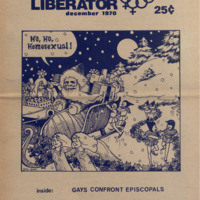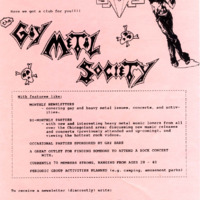
About the LGBTQ+ Midwestern Print Culture Archive
LGBTQ+ Midwestern Print Culture: An Archive is a collection of LGBTQ+ zines, posters, flyers, newspapers, and magazines published in the North American Midwest between 1969 and 2000. When selecting materials for inclusion in this archive, we tried to represent a diversity of sexual, racial, and political identities as well as geographical and socioeconomic groups. We hope that this digital archive can be a resource to LGBTQ+ community members and activists, especially those interested in learning more about the histories of Queer activism, print culture, social life, and organizations in the Midwest region during the period of heightened cultural and political activity following the Stonewall Riots in 1969. It is our intention that activists might use the materials in our archive to glean practical information about historical forms of LGBTQ+ resistance and community-building: how these communities succeeded in providing support to one another and enacting change through the materials they created and circulated; and, on the other hand, how they sometimes failed, suffering from the pressures they faced from within and without their communities. In particular, our collection might be useful to LGBTQ+ individuals and organizations operating in the Midwest, where isolation and lack of resources as compared to more densely-populated areas continue to present unique challenges to Queer communities.
This archive is by no means exhaustive, nor is it perfect. We invite users to engage with us in the radical act of remembering, preserving, and sharing LGBTQ+ histories. You can do so by adding tags to items and by submitting your own materials to the collection through this submission form.*
* This archive was created as part of a class project for SI 580: Understanding Records and Archives at the University of Michigan School of Information. As such, it will not be updated or monitored past December 8th, 2021.
Archival Concepts
- Collective Memory: The LGBTQ+ Midwestern Print Culture Archive seeks to help sustain the cultural traditions, histories, and values of LGBTQ+ communities in the midwest by assembling and describing digitized forms of print artifacts (e.g. zines, posters, publications, newsletters) created by and for these communities during the second half of the 20th century (Foote, 1990). We aim to highlight not only the historical significance of these 'ephemeral' materials, but also their enduring aesthetic value.
- Assemblage: Our archive deploys an "assemblage perspective," encouraging users to discover multiple types of relationships between records (Brilmyer, 2018, p. 109). By displaying our materials in a grid-like form in our browse section, we foreground the relations betweens artifacts in the hope that users make meaningful connections between items that exceed a fonds-based approach.
- Post-custodial Archiving: By now, many archival scholars, including Duff and Harris (2002) and Wood et. al. (2014) have described the advantages of inviting archive-users to take an active role in narrating and arranging archival records. We encourage users, particularly members of the LGBTQ+ community, to contribute to this archive through tagging and community submissions, in order to enrich the historical record with their own experiences and cultural knowledge. We hope, therefore, that our archive might serve primarily as a digital "space for Queer community members to come together and remember the past" (Wakimoto et. al., 2013, p. 305).
- Ethics of LGBTQ+ Archiving: In dealing with documents from and about LGBTQ+ people, archival scholars have emphasized the need for caution to avoid outing closeted members of the community (Hodson, 2004, p. 200). While we considered options for protecting the privacy of those who contributed to these publications in our archive, we also took note of the way these publications took steps to protect their contributors, often identifying contributors only by first name or pseudonym. Participant models of provenance and ownership, arguing that "every contributor... has legal and moral rights and responsibilities in relation to ownership, access and privacy", provided us with some guidance here (Iacovino, 2010, p. 362). We've chosen to respect the way these contirbutors have represented themselves in these documents, and reproduce whatever name or pseudonym they've chosen in our metadata.
A Note on Language
Please be aware before browsing our collection that many of the materials contain sensitive language and content that may be offensive to some visitors. The publications of this archive provided its readers, editors, and contributors the chance to discuss, debate, and reflect upon the many facets of their experience as LGBTQ+ people. This included, at times, frank discussions of sexual violence, physical abuse, and other traumatic experiences. Users of this archive should also be aware that these documents demonstrate the linguistic reappropriation of slurs, pejoratives, and other discriminatory terminology used against LGBTQ+ people, which appear throughout the collection. Additionally, some of our documents include slurs and pejoratives when recounting experiences of racism and discrimination. Our items are not individually tagged with specific content warnings, but we encourage visitors to implement a tagging system as they see fit and necessary.
Why "LGBTQ+"?
Historically, there have been many different terms by which LGBTQ+ communities in different places and contexts have identified themselves and been identified by others. For the purposes of this project, we use "LGBTQ+" to refer to individuals and communities who have a non-normative gender identity or sexual orientation (i.e. people who identify as non-straight and/or non-cisgender). LGBTQ+ stands for Lesbian, Gay, Bisexual. Transgender, and Queer. The "+" acknowledges that there are non-cisgender and non-straight identities that are not included in the acronym. We chose to use LGBTQ+ as it serves as an umbrella term that includes the identities most commonly found in this archive, while also leaving room for ambiguity and fluidity. When encountering these historical documents, it is important to remember that sexual orientation and gender are not only deeply personal experiences but that these identities and the words that people use to describe them are both culturally and historically contingent.







